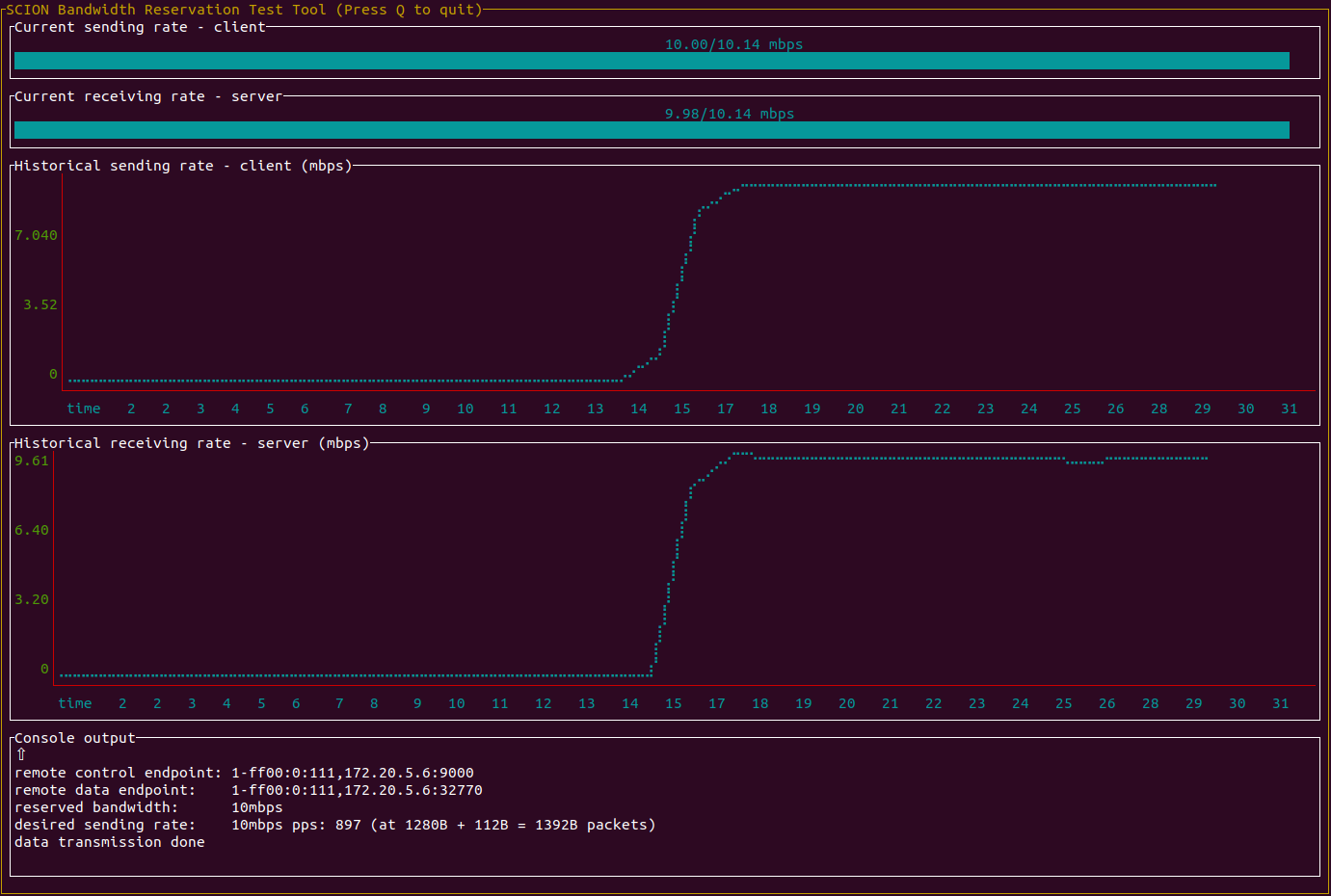bwallocation is a go library for establishing bandwidth reservations in the
bandwidth allocation system.
go get -u github.com/anapaya/bwallocation/cmd/bwreserverThis package defines a go library to interact with the bandwidth allocation system. Check the go documentation for more details.
The sample application bwreserver showcases how bandwidth reservations can
be obtained and used. The application runs in client and server mode.
Usage:
bwreserver server [flags]
Examples:
bwreserver server --local :9000
Flags:
--dispatcher string dispatcher socket (default "/run/shm/dispatcher/default.sock")
-h, --help help for server
--local udp-addr Address to listen on (default :9000)
--log.level string Console logging level verbosity (debug|info|error)
--pprof tcp-addr Address to serve pprof (default :0)
--sciond string SCION Daemon address (default "127.0.0.1:30255")
The client supports two protocols UDP/SCION and QUIC/SCION. By default UDP/SCION
is used. QUIC/SCION can be enabled with the appropriate flag.
The paths can be filtered according to a sequence. A sequence is a string of
space separated HopPredicates. A Hop Predicate (HP) is of the form
'ISD-AS#IF,IF'. The first IF means the inbound interface (the interface where
packet enters the AS) and the second IF means the outbound interface (the
interface where packet leaves the AS). 0 can be used as a wildcard for ISD, AS
and both IF elements independently.
HopPredicate Examples:
Match any: 0
Match ISD 1: 1
Match AS 1-ff00:0:133: 1-ff00:0:133
Match IF 2 of AS 1-ff00:0:133: 1-ff00:0:133#2
Match inbound IF 2 of AS 1-ff00:0:133: 1-ff00:0:133#2,0
Match outbound IF 2 of AS 1-ff00:0:133: 1-ff00:0:133#0,2
Sequence Examples:
sequence: "1-ff00:0:133#0 1-ff00:0:120#2,1 0 0 1-ff00:0:110#0"
The above example specifies a path from any interface in AS 1-ff00:0:133 to
two subsequent interfaces in AS 1-ff00:0:120 (entering on interface 2 and
exiting on interface 1), then there are two wildcards that each match any AS.
The path must end with any interface in AS 1-ff00:0:110.
sequence: "1-ff00:0:133#1 1+ 2-ff00:0:1? 2-ff00:0:233#1"
The above example includes operators and specifies a path from interface
1-ff00:0:133#1 through multiple ASes in ISD 1, that may (but does not need to)
traverse AS 2-ff00:0:1 and then reaches its destination on 2-ff00:0:233#1.
Available operators:
? (the preceding HopPredicate may appear at most once)
+ (the preceding ISD-level HopPredicate must appear at least once)
* (the preceding ISD-level HopPredicate may appear zero or more times)
| (logical OR)
Usage:
bwreserver client <server-addr> [flags]
Examples:
bwreserver client 1-ff00:0:112,127.0.0.1:9000 -s 5mbps -d 10
bwreserver client 1-ff00:0:112,127.0.0.1:9000 -s 10mbps -r 5mbps
bwreserver client 1-ff00:0:112,127.0.0.1:9000 --text
Flags:
-d, --duration int duration of the data transmission in seconds.
0 or negative values will keep the data transmission going indefinitely.
-h, --help help for client
-i, --interactive interactive mode
--local ip IP address to listen on
--log.level string Console logging level verbosity (debug|info|error)
--payload int payload size in bytes (default 1280)
--pprof tcp-addr Address to serve pprof (default :0)
--quic use QUIC when sending data. If not specified, UDP is used.
-r, --reservation string bandwidth to reserve. Setting this lower than sending rate simulates malicious behavior.
supported values:
<bandwidth>: Reserve the specified bandwidth
sending-rate: Use same value as sending-rate
none: Do not reserve any bandwidth
(default "sending-rate")
--sciond string SCION Daemon address (default "127.0.0.1:30255")
-s, --sending-rate string rate the client attempts to send at (default "1mbps")
--sequence string Space separated list of hop predicates
--text use simple text mode. If not specified, the CLI widgets output is used.The following requirements are assumed for development:
- go v1.15
- mockgen v1.4.4
- protoc v3.11.4
- protoc-gen-go v1.22.0
- protoc-gen-go-grpc v1.0.1
make test
make mocks
make proto






